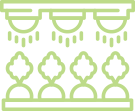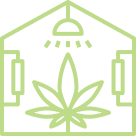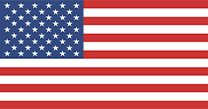
November 6, 2025
The right lighting setup can increase your yields and enhance plant quality, but understanding lighting terminology and processes can be a bit intimidating.
We’re breaking down the essential lighting basics every grower should understand, so you can make smarter decisions and get the best results from your space.
PPFD
PPFD: Photosynthetic Photon Flux Density
This tells you how much usable light is reaching your plants’ leaves. PPFD is measured in µmol/m²/s. Think of it like fuel for photosynthesis: the more light = the more energy your plants have to grow. The ideal level of PPFD depends on the type of plant and the stage of growth.
- Low PPFD = slow growth and poor yield
- High but uneven PPFD = stressed or inconsistent plants
- Optimal PPFD = vigorous growth, better quality, more consistency
Light Spectrum
Spectrum describes the different colors of light that impact how plants grow (blue, red, far-red, etc.) and each color plays a different role in plant development. Plants need to receive the right kind of light to thrive.
- Blue light (400–500 nm): Increases dense growth (great for the finishing stages of flower)
- Red light (600–700 nm): Drives flowering in the beginning and mid-stages of growth
- Far-red light (700–750+ nm): Can boost size, speed, and yield (if used correctly, but be careful. Excessive use of far-red light can cause photobleaching)
The right spectrum will make a big difference in plant growth, since different plants require different spectrums at various stages.

Spectrum Examples Above
Under Canopy Lighting
Overhead lighting can struggle to reach the lower branches through a dense canopy, which means lower buds don’t receive as much light and get stunted.
Under canopy lighting solves that by sending light up from below. Numerous studies, including our own, have shown that getting more light to the bottom of the canopy can help plant growth and quality.
Benefits include:
- Bigger, better lower buds
- More uniform growth and ripening
- Better use of your existing square footage
If you’re looking to improve yields by up to 40% without expanding your footprint, JumpLights Catalyst Pro is a smart place to focus.

Lighting Layouts
A lighting layout (or photometric map) shows how light is distributed across your space. These visual maps highlight where light levels are too high, too low, or just right.
Key terms:
- Eav: The average amount of light across the space
- Emin / Emax: The lowest and highest light levels
- Uniformity (u0): A measure of how evenly the light is distributed
Ideally, you want your whole canopy to fall within a consistent range. Gaps in coverage or hotspots can cause uneven growth and waste potential yield.
Efficiency
Many people assume that more watts = more light. But what really matters is how efficiently that energy is converted into usable light.
That’s measured by PPE — Photosynthetic Photon Efficacy (in µmol/J). Higher the PPE, means more usable light per watt of electricity. High-quality LEDs deliver high PPFD while using less energy.
Higher PPE means:
- Lower energy bills
- Cooler environments (less heat to manage)
- Better ROI
So, to wrap it all up:
PPFD tells you how much light output is reaching the plants canopy
Spectrum influences how your plants grow
Under-canopy lighting creates more opportunities for cannabis growth
Layouts show how evenly your lighting is distributed
Efficiency (PPE) matters more than just power
Hopefully this guide will help strengthen your understanding and lead to stronger plants and better results. The JumpLights team is happy to answer any questions you have about lighting or your grow space. Just get in touch today!




